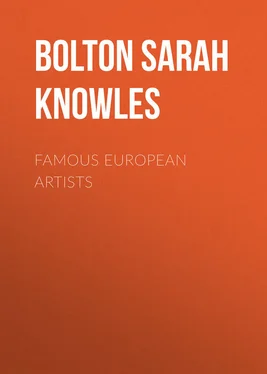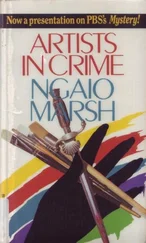Sarah Bolton - Famous European Artists
Здесь есть возможность читать онлайн «Sarah Bolton - Famous European Artists» — ознакомительный отрывок электронной книги совершенно бесплатно, а после прочтения отрывка купить полную версию. В некоторых случаях можно слушать аудио, скачать через торрент в формате fb2 и присутствует краткое содержание. ISBN: , Жанр: foreign_prose, foreign_antique, foreign_language, на английском языке. Описание произведения, (предисловие) а так же отзывы посетителей доступны на портале библиотеки ЛибКат.
- Название:Famous European Artists
- Автор:
- Жанр:
- Год:неизвестен
- ISBN:http://www.gutenberg.org/ebooks/39380
- Рейтинг книги:5 / 5. Голосов: 1
-
Избранное:Добавить в избранное
- Отзывы:
-
Ваша оценка:
- 100
- 1
- 2
- 3
- 4
- 5
Famous European Artists: краткое содержание, описание и аннотация
Предлагаем к чтению аннотацию, описание, краткое содержание или предисловие (зависит от того, что написал сам автор книги «Famous European Artists»). Если вы не нашли необходимую информацию о книге — напишите в комментариях, мы постараемся отыскать её.
Famous European Artists — читать онлайн ознакомительный отрывок
Ниже представлен текст книги, разбитый по страницам. Система сохранения места последней прочитанной страницы, позволяет с удобством читать онлайн бесплатно книгу «Famous European Artists», без необходимости каждый раз заново искать на чём Вы остановились. Поставьте закладку, и сможете в любой момент перейти на страницу, на которой закончили чтение.
Интервал:
Закладка:
Upon his return to Florence, Cardinal Piccolomini, afterwards Pius III., made a contract with him for fifteen statues of Carrara marble to embellish the family chapel in the cathedral of Siena. Three years were allowed for this work. The artist finished but four statues, Peter, Paul, Gregory, and Pius, because of other labors which were pressed upon him.
The marble Madonna in the Church of Notre Dame at Bruges was carved about this time. "This," says Grimm, "is one of Michael Angelo's finest works. It is life-size. She sits there enveloped in the softest drapery; the child stands between her knees, leaning on the left one, the foot of which rests on a block of stone, so that it is raised a little higher than the right. On this stone the child also stands, and seems about to step down. His mother holds him back with her left hand, while the right rests on her lap with a book. She is looking straight forward; a handkerchief is placed across her hair, and falls softly, on both sides, on her neck and shoulders. In her countenance, in her look, there is a wonderful majesty, a queenly gravity, as if she felt the thousand pious glances of the people who look up to her on the altar."
An opportunity now presented itself for the already famous sculptor to distinguish himself in his own city. Years before a marble block, eighteen feet high, had been brought from Carrara to Florence, from which the wool-weavers' guild intended to have a prophet made for Santa Maria del Fiore. One sculptor had attempted and failed. Others to whom it was offered said nothing could be done with the one block, but more pieces of marble should be added.
Michael Angelo was willing to undertake the making of a statue. He was allowed two years in which to complete it, with a monthly salary of six gold florins. His only preparation for the work was a little wax model which he moulded, now in the Uffizi. He worked untiringly, so that he often slept with his clothes on, to be ready for his beloved statue as soon as the morning dawned. He had shut himself away from the public gaze by planks and masonry, and worked alone, not intrusting a stroke to other hands. He felt what Emerson preached years later, that "society is fatal." The great essayist urged that while we may keep our hands in society "we must keep our head in solitude." Great thoughts are not born usually in the whirl of social life.
Finally, when the statue was finished in January, 1504, and the colossal David stood unveiled before the people, they said: "It is as great a miracle as if a dead body had been raised to life." Vasari says Michael Angelo intended, by this work, to teach the Florentines that as David "had defended his people and governed justly, so they who were then ruling that city should defend it with courage and govern it uprightly."
The statue weighed eighteen thousand pounds, and required forty men four days to drag it by ropes a quarter of a mile to the place where it was to stand in the Piazza della Signoria. Notwithstanding that the praise of the sculptor was on every lip, still there was so much jealousy among the artists that some of their followers threw stones at the statue during the nights when it was being carried to the Piazza, and eight persons were arrested and put in prison.
Vasari tells a story which, whether true or false, illustrates the character of those who profess much because they know little. "When the statue was set up, it chanced that Soderini, whom it greatly pleased, came to look at it while Michael Angelo was retouching it at certain points, and told the artist that he thought the nose too short. Michael Angelo perceived that Soderini was in such a position beneath the figure that he could not see it conveniently; yet, to satisfy him, he mounted the scaffold with his chisel and a little powder gathered from the floor in his hand, when striking lightly with the chisel, but without altering the nose, he suffered a little of the powder to fall, and then said to the gonfaloniere, who stood below, 'Look at it now.'
"'I like it better now,' was the reply; 'you have given it life.' Michael Angelo then descended, not without compassion for those who desire to appear good judges of matters whereof they know nothing." But the artist very wisely made no remarks, and thus retained the friendship of Soderini. In 1873, after nearly four centuries, this famous statue was removed to the Academy of Fine Arts in the old Monastery of St. Mark, lest in the distant future it should be injured by exposure.
Work now poured in upon Michael Angelo. In three years he received commissions to carve thirty-seven statues. For the cathedral of Florence he promised colossal statues of the twelve apostles, but was able to attempt only one, St. Matthew, now in the Florentine Academy. For Agnolo Doni he painted a Madonna, now in the Tribune at Florence. The price was sixty ducats, but the parsimonious Agnolo said he would give but forty, though he knew it was worth more. Michael Angelo at once sent a messenger demanding a hundred ducats or the picture, but, not inclined to lose so valuable a work by a famous artist, Agnolo gladly offered the sixty which he at first refused to pay. Offended by such penuriousness, Michael Angelo demanded and received one hundred and forty ducats!
In 1504, Gonfaloniere Soderini desired to adorn the great Municipal Hall with the paintings of two masters, Leonardo da Vinci and Michael Angelo. The latter was only twenty-nine, while Da Vinci was over fifty. He had recently come from Milan, where he had been painting the "Last Supper," which, Grimm says, "in moments of admiration, forces from us the assertion that it is the finest and sublimest composition ever produced by an Italian master."
And now with this "first painter in Italy" the first sculptor, Michael Angelo, was asked to compete, and he dared to accept the offer.
He chose for his subject an incident of the Pisan war. As the weather was very warm, the Florentines had laid aside their armor and were bathing in the Arno. Sir John Hawkwood, the commander of the opposing forces, seized this moment to make the attack. The bathers rushed to the shore, and Michael Angelo has depicted them climbing the bank, buckling on their armor, and with all haste returning the assault.
"It is not possible," says Grimm, "to describe all the separate figures, the fore-shortenings, the boldness with which the most difficult attitude is ever chosen, or the art with which it is depicted. This cartoon was the school for a whole generation of artists, who made their first studies from it."
Da Vinci's painting represented a scene at the battle of Anghiari, where the Florentines had defeated the Milanese in 1440. "While these cartoons thus hung opposite to each other," says Benvenuto Cellini, "they formed the school of the world." Raphael, Andrea del Sarto, and others made studies from them. Da Vinci's faded, and Michael Angelo's was cut in pieces by some enemy.
Before the artist had finished his painting he was summoned to Rome by Pope Julius II., the great patron of art and literature, who desired a monument for himself in St. Peter's. The mausoleum was to be three stories high; with sixteen statues of the captive liberal arts, and ten statues of Victory treading upon conquered provinces, for the first story; the sarcophagus of the pope, with his statue and attendant angels, for the second; and, above all, more cherubs and apostles.
"It will cost a hundred thousand crowns," said the artist.
"Let it cost twice that sum," said the pope.
At once Michael Angelo hastened to the marble quarries of Carrara, in the most northern part of Tuscany, where he remained for eight months. His task was a difficult one. He wrote to his father after he had gone back to Rome, "I should be quite contented here if only my marble would come. I am unhappy about it; for not for two days only, but as long as I have been here, we have had good weather. A few days ago, a bark, which has just arrived, was within a hair's-breadth of perishing. When from bad weather the blocks were conveyed by land, the river overflowed, and placed them under water; so that up to this day I have been able to do nothing. I must endeavor to keep the pope in good humor by empty words, so that his good temper may not fail. I hope all may soon be in order, and that I may begin my work. God grant it!"
Читать дальшеИнтервал:
Закладка:
Похожие книги на «Famous European Artists»
Представляем Вашему вниманию похожие книги на «Famous European Artists» списком для выбора. Мы отобрали схожую по названию и смыслу литературу в надежде предоставить читателям больше вариантов отыскать новые, интересные, ещё непрочитанные произведения.
Обсуждение, отзывы о книге «Famous European Artists» и просто собственные мнения читателей. Оставьте ваши комментарии, напишите, что Вы думаете о произведении, его смысле или главных героях. Укажите что конкретно понравилось, а что нет, и почему Вы так считаете.












